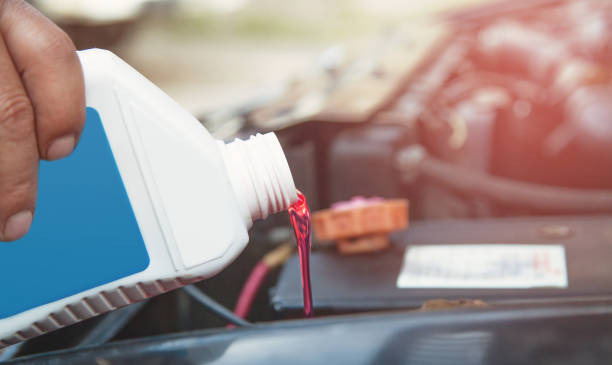
Selecting the proper transmission fluid is vital to keep your vehicle's transmission operating smoothly. The wrong fluid can damage seals and cause leaks or other problems. This buyer's guide provides tips on how to select the right transmission fluid for your specific vehicle.
What is Transmission Fluid?
Transmission fluid serves several important functions:
- It provides lubrication to the transmission's internal components to reduce friction. This allows the transmission to shift smoothly.
- It transfers heat from the transmission to help keep it from overheating.
- It helps maintain seals to prevent leaks.
- It keeps internal components clean.
- It provides hydraulic pressure to certain automatic transmissions. This hydraulic action is what allows fluid transmissions to shift gears.
Manual vs. Automatic Transmission Fluids
There are differences between fluids designed for manual transmissions and those for automatic transmissions:
- Manual transmission fluid - These fluids need to reduce friction and provide general lubrication. They do not require advanced additives to aid in shifting or other functions.
- Automatic transmission fluid (ATF) - This fluid is formulated with special additive packages. These additives improve lubrication while also providing the hydraulic properties needed for automatic shift transmissions. The additives help smooth shifts and transfer power.
Types of Transmission Fluid
Understanding the general types of fluids available is important in choosing the right product:
- OEM fluids - These are fluids made by the original manufacturer specifically for certain transmission models. Honda, GM, Chrysler, and others all formulate their own branded fluids for their transmissions. Using the OEM fluid is always the preferred option if available for your vehicle.
- Aftermarket branded fluids - Companies like Valvoline, Castrol, and Royal Purple manufacture transmission fluids marketed for use in certain vehicles. But they are not OEM fluids. Make sure any aftermarket fluid you use is recommended for your specific transmission.
- Generic/universal fluids - Basic universal automatic transmission fluids are available from various brands. These are made for general use but may not perform as well as a fluid tailored for your transmission.
- CVT fluids - CVT or continuously variable transmissions require special CVT fluid designed for their unique components and operation. Make sure to use only CVT fluid in any continuously variable transmission.
Key Specifications
When comparing transmission fluid products, keep these key specifications in mind:
- Viscosity - The fluid's viscosity rating affects lubrication and internal hydraulic pressure. Make sure to get a fluid with the viscosity recommended for your transmission.
- Friction modifiers - Friction reducing additives promote smooth shifting. Not all fluids contain sufficient additives.
- Quality standards - Look for fluids that meet or exceed standards from GM, Ford, and other manufacturers. This indicates quality formulations.
- Seal conditioners - Some fluids contain seal swelling agents to prevent hardening and shrinking.
How to Check Your Current Transmission Fluid
Before selecting a replacement fluid, check your current fluid to determine what type you need:
- Park your vehicle on a level surface and engage the emergency brake. Start the engine and allow it to reach operating temperature.
- Locate the transmission dipstick, usually found near the rear of the engine bay. Pull out the dipstick and wipe it off with a clean rag.
- Reinsert the dipstick fully and pull it out again. Note the fluid color and level. Transmission fluid should be pinkish and free of particles.
- Compare the fluid on your dipstick to the recommended shade for your transmission. If it is dark, smells burnt, or looks gritty, a fluid change is likely needed.
- Note the dipstick markings to see if you need to top off the fluid level. Do not overfill beyond the "Full" line.
- Refer to your owner's manual for specific details on your vehicle's transmission and fluid checking process.
Choosing the Right Fluid
With the right information, you can select compatible transmission fluid:
- Refer to your owner's manual for the manufacturer's recommended fluid type and specifications. This is the most important factor.
- If using an aftermarket fluid, verify it is approved for use in your specific transmission. Check that specifications like viscosity and friction properties match what your transmission requires.
- For older transmissions low on fluid, consider adding a bottle of universal ATF to top it off until you can get the proper fluid. But do not use universal fluid for a complete change.
- When switching fluid types, you may need to flush the system first to fully clear out old fluid residue. A fluid exchange machine can handle this.
- If unsure about choosing a replacement fluid, consult your transmission shop or dealer to verify what fluid type to use.
Signs You Need a Transmission Fluid Change
Notice these signs your transmission fluid needs to be changed:
- Dark or burnt smelling fluid
- Slipping gears or delayed shifts
- Changes in the color or level of fluid
- Leaks originating from seals and gaskets
- Whining or clunking sounds when shifting
Fluid should be changed based on your carmaker's schedule, usually every 30,000 to 60,000 miles. Consult your manual for specifics.
Changing the fluid properly flushes old fluid and deposits from internal components. Use a pump machine to exchange fluid if possible. Always use the correct fluid type when refilling.
Proper Driving Habits Prolong Transmission Life
Your driving habits can shorten transmission lifespan and fluid life:
- Aggressive driving - This puts more stress on the transmission.
- Towing or hauling - Hauling heavy loads increases heat and wear.
- Stop-and-go traffic - More gear changes cause faster breakdown of fluid.
To maximize transmission life:
- Accelerate gradually and avoid "jackrabbit" starts.
- Come to smooth, gradual stops instead of abrupt halts.
- Shift gently between gears instead of forceful shifts.
- Change fluid at regular intervals.
Signs of Contaminated or Worn Out Fluid
Transmission problems are often caused by fluid issues like:
- Leaks - Low fluid levels can cause damage and leaks.
- Sludge - Sludge buildup can clog valves and other components.
- Wrong fluid - Improper fluids can damage seals and lead to leaks.
- Overheating - Burnt and oxidized fluid fails to lubricate and transfer heat properly.
Noticing symptoms like slipping, hesitation, or leaks is a sign to get your fluid checked or changed immediately. Continuing to operate the vehicle when the fluid is contaminated can lead to complete transmission failure.
Final Words
Choosing the proper transmission fluid improves performance and longevity in your car or truck’s transmission. Follow your manufacturer’s recommendations for the specific fluid type and service intervals. High quality fluids matching your transmission's needs will provide optimum lubrication, hydraulic operation, and component protection. With the right fluid, your transmission will shift smoothly for years to come.



